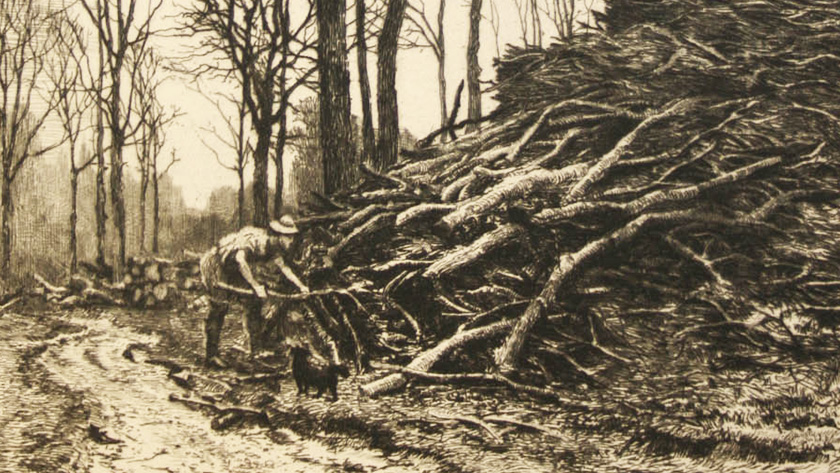
Detail of Winter Fuel, an etching by Frederick Albert Slocombe.
A View from the Vault: Frederick Albert Slocombe’s Winter Fuel
By Ashley Rye-Kopec, Museums
“A View from the Vault” showcases some of the unique, notable or rare items that are a part of the Special Collections and Museums holdings at the University of Delaware. Each month, we highlight a different item and share interesting facts or intriguing histories about it. If you are interested in seeing any of the materials featured in person or want to learn more about anything showcased in the series, please contact Special Collections and Museums at AskSpec or AskMuseums.

Winter Fuel by Frederick Albert Slocombe. Click here or on the image for larger view.
Frederick Albert Slocombe (England, 1847-1920)
Winter Fuel
Undated (about 1880s)
Etching and drypoint on paper
Museums Collections, Gift of Mrs. John Sloan
In this etching, Frederick Albert Slocombe captures a quintessential winter landscape. Tall, spindly trees reach upward, providing a dark silhouette against the bright sky. Almost entirely devoid of leaves, the bare branches signal that autumn has passed and winter has arrived. In the foreground, almost hidden next to a pile of fallen branches, a man bends over to chop firewood. The print’s title, Winter Fuel, connects the man’s action to the season – the logs, once chopped, will be used as fuel, likely for the wood stove that heats the man’s home.
Frederick Slocombe (or “Fred,” as he frequently signed his art) was a British painter and etcher who gained popularity in the late 19th century. He depicted a variety of subjects in his art, but his etchings commonly featured rural landscapes such as this one. These types of landscape scenes became especially popular during the etching revival of the late 19th century, as artists brought renewed attention to the creative possibilities of the etching technique. The Museums Collections are rich in materials relating to the etching revival and the printing processes of the 19th century.
